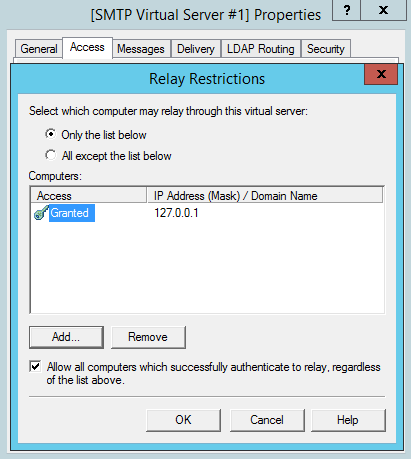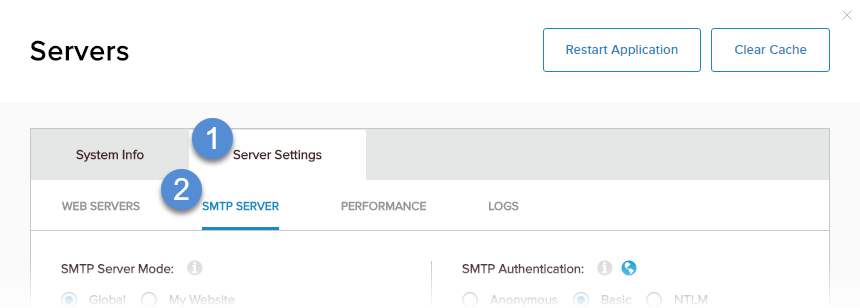- Outgoing mail server (SMTP): smtp.live.com Logon Information: User Name: your @outlook.com email address Password: your @outlook.com password. Then click on the “More Settings” button: Outgoing Server tab: mark the box “My outgoing server (SMTP) requires authentication” and select “use same settings as my incoming mail server”.
- Configure a SMTP server in Azure Posted on February 17, 2016 by admin Sometimes in my scripts I need to send the result in a mail, but I don’t always have access to a SMTP server, so I decided to configure a SMTP server in Azure that I can use.
- SMTP server settings are only used to send mail from the Outlook.com address. To download and store incoming messages from an Outlook.com account, you'll need the settings for either a POP3 or IMAP account. Depending on which standard you use on your devices, enter either the Outlook.com POP server settings or the Outlook.com IMAP server settings.
Hi, I'm new to Windows Server management and I'm currently configuring a SMTP server on a Windows Server 2016, because I have an ecommerce running on the server and I need the SMTP relay set up. I've installed it through Server Manager/Add Roles and made some configurations like authentication. Hi, As SMTP is IIS relate configuration, please post. Then for the SMTP server, it will by default show your custom domain. However, you will want to change this to use Google’s free SMTP server. So change it to smtp.gmail.com. Then enter in your personal Gmail address for the username (yourname@gmail.com) and your password. This is the app password you generated earlier, not your Gmail password. To synchronize your Gmail account with an outside email client, such as Outlook, give the server instructions for how to send your Gmail emails in the form of Simple Mail Transfer Protocol (SMTP) server settings. The settings are the same for any email provider you use with Gmail.
Do you need these mail server settings?
You can use the mail server settings in this article to manually set up your email app to send and receive email with an iCloud email account. However, you shouldn't need to do that if you meet iCloud system requirements and can use any of these setup methods:
- Use iCloud Preferences on your Mac in OS X Lion 10.7.4 or later.
- Use iCloud for Windows on your PC in Microsoft Windows with Outlook 2010 through Outlook 2016. Set up two-factor authentication and, if needed, generate an app-specific password* to use for iCloud Mail.
- Use iCloud settings on your iPhone, iPad, or iPod touch with iOS 7 or later.
Mail server settings
Refer to your email app's documentation for information about how to use these settings. iCloud Mail uses the IMAP and SMTP standards supported by most modern email apps. iCloud does not support POP. If you set up an account using iCloud System Preferences or macOS Mail in 10.7.4 or later, you won't see these settings because they're automatically configured.
IMAP information for the incoming mail server

- Server name: imap.mail.me.com
- SSL Required: Yes
If you see an error message when using SSL, try using TLS instead. - Port: 993
- Username: This is usually the name part of your iCloud email address (for example, emilyparker, not emilyparker@icloud.com). If your email client can't connect to iCloud using just the name part of your iCloud email address, try using the full address.
- Password: Generate an app-specific password.
SMTP information for the outgoing mail server
- Server name: smtp.mail.me.com
- SSL Required: Yes
If you see an error message when using SSL, try using TLS or STARTTLS instead. - Port: 587
- SMTP Authentication Required: Yes
- Username: Your full iCloud email address (for example, emilyparker@icloud.com, not emilyparker)
- Password: Use the app-specific password that you generated when you set up the incoming mail server.
* You only need to use an app-specific password if you’re manually setting up mail with your iCloud account in Windows, if you use Mac OS X Mail (10.7.4 and earlier), or if you use any other third-party mail client.
Office 365 is a cloud platform that businesses use for their day-to-day activities and make their environment more collaborative. The email server of Office 365, namely Exchange Online, is popular among enterprises. Office 365 end users configure their accounts on Outlook to access their mailboxes. The process is similar to web mail users configuring their email accounts like Gmail on email clients like Outlook, Thunderbird, etc. to access their mailboxes on their personal computers. While configuring web mail or Office 365 account on an email client like Outlook, users need to be aware of various settings such IMAP, POP, and SMTP with Office 365.
But, many people often don’t understand the configuration settings of IMAP, POP, and SMTP email servers. So, here we will talk about how SMTP, IMAP, and POP are different from each other, and what are settings of Office 365 and some popular email clients.
SMTP
Known as Simple Mail Transfer Protocol – SMTP— is used for sending out emails from an email client like Thunderbird or Apple Mail to another email server. The primary function of SMTP is entirely different than that of IMAP and POP. SMTP is also used for relaying and forwarding emails from one mail server to another.
The SMTP uses port 25 by default, though it can also use port 587 and 465. The last was introduced as the port of choice for secure SMTP, which is still used by many mail service providers.
POP3
Known as Post Office Protocol – POP– is used for retrieving emails from a mail server to a mail client. POP3 is the latest version that is widely used by most email clients. It supports extensions and several authentication mechanisms. A POP client can retrieve emails in the following manner:
- Connects with the email server on port number 110 and 995 for SSL/TLS connections
- Retrieves email messages
- Deletes copies of the emails stored on the server
- Disconnects from the server

Also, POP clients are configured to enable the server to continue storing copies of the downloaded messages.
IMAP
IMAP is a more complex protocol, especially the current version IMAP4. The IMAP email clients are equipped with message flags that indicate whether messages are read, replied, or deleted. It even allows users to search against server mailboxes.
Microsoft Exchange Server 2010 Smtp Settings
The IMAP email server works in the following manner:
- Connects to the email server with port number 143, and 993 for SSL/TLS connections
- Retrieves email messages
- Disconnects after email client app is closed
Note: The emails or messages in IMAP are not deleted on the server.
Configuring IMAP, POP, and SMTP in Office 365
Most users access their Office 365 account via Outlook or Outlook on the web. So, to add any account to Outlook, you’ll need information like the type of account, server names, and the SSL and port settings. Usually, you can get these settings from the email provider, but to make it convenient for you, we mentioned the server settings for most popular email providers along with Office 365.
| Email Provider | IMAP Settings | POP Settings | SMTP Settings |
|---|---|---|---|
| AOL (Including Verizon.net) | Server: imap.aol.com Port: 993 Encryption: SSL/TLS | Server: pop.aol.com Port: 995 Encryption: SSL/TLS | Server: smtp.aol.com Port: 465 Encryption: SSL/TLS |
| Gmail | Server: imap.gmail.com Port: 993 Encryption: SSL/TLS | Server:pop.gmail.com Port: 995 Encryption: SSL/TLS | Server: smtp.gmail.com Port: 465 Encryption: SSL/TLS |
| iCloud | Server: imap.mail.me.com Port: 993 Encryption: SSL/TLS | Server: Port: Encryption: | Server: smtp.mail.me.com Port: 587 Encryption: STARTTLS |
| MSN | Server: imap-mail.outlook.com Port: 993 Encryption: SSL/TLS | Server: pop-mail.outlook.com Port: 995 Encryption: SSL/TLS | Server: smtp-mail.outlook.com Port: 587 Encryption: STARTTLS |
| Office 365 | Server: outlook.office365.com Port: 993 Encryption: SSL/TLS | Server: outlook.office365.com Port: 995 Encryption: SSL/TLS | Server: smtp.office365.com Port: 587 Encryption: STARTTLS |
| Outlook.com Hotmail.com Live.com | Server: imap-mail.outlook.com Port: 993 Encryption: SSL/TLS | Server: pop-mail.outlook.com Port: 995 Encryption: SSL/TLS | Server: smtp-mail.outlook.com Port: 587 Encryption: STARTTLS |
| Yahoo! | Server: imap.mail.yahoo.com Port: 993 Encryption: SSL | Server: pop.mail.yahoo.com Port: 995 Encryption: SSL | Server: smtp.mail.yahoo.com Port: 587 or 465 Encryption: TLS/STARTTLS or SSL |
Setup Microsoft Smtp Server
Consideration for Choosing Between IMAP and POP
Microsoft Smtp Server Settings
Well, it’s hard to pick one among these for sending and receiving emails. So, many factors are to be considered while choosing between IMAP and POP3.
- Server Storage Space
- Access Anytime and Anywhere
- Synchronization
- Privacy
As IMAP leaves messages on the server; it consumes more storage space as compared to POP3. So, if your server is offering less storage space, then POP3 is a better choice.
IMAP enables accessing messages from multiple devices, which means if you have an iPhone, Android phone, a desktop, or a laptop, with IMAP you can read your emails from any of these devices.
Using an IMAP email server, you can achieve all the synchronization that a user needs with an email account, such as reflecting whatever action you performed on one device.
Privacy is a significant concern for almost every user. Such users often prefer to download all these emails and leave no copies behind on the server. For such users, POP3 is a better option to choose.
Microsoft Smtp Server Settings Comcast
These options are enough to tell you which email server is a better option for you. However, if you want to migrate from an IMAP account to Office 365, then you’ll have to take help from a professional tool like Kernel IMAP to Office 365. This tool will help you migrate every single mailbox item from your IMAP account to Office 365.